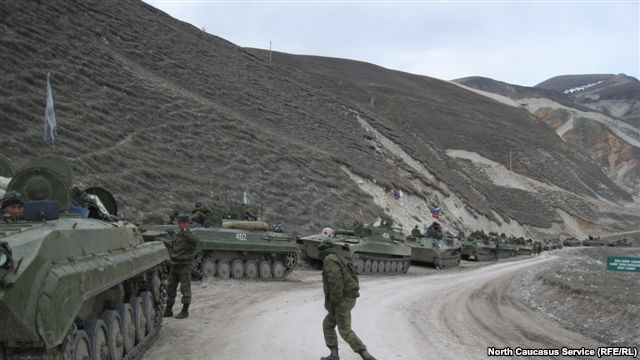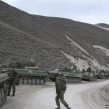
Russia Launches Massive Military Redeployment to Dagestan
Publication: Eurasia Daily Monitor Volume: 9 Issue: 57
By:

On March 18, Russia’s Interior Ministry officially confirmed a massive relocation of ministry troops from Chechnya to Dagestan. The official reason given for the movement of the troops was to “stabilize” the situation in Dagestan. A temporary command was set up in Dagestan to coordinate the Interior Ministry troops in the republic. The troops will be stationed in the most volatile districts of both the mountains and the lowlands of the republic (https://guskfo.ru/sluzhby/vogoip/316-policiya-beret-kurs-na-dagestan.html, March 18).
Citing a source in Chechnya’s law enforcement agencies, the Kavkazsky Uzel (Caucasian Knot) website reported that an estimated 20,000 servicemen (roughly the size of the entire Georgian army) were being redeployed to Dagestan. In an interview with the website, a resident of Chechnya’s Gudermes district, Sultan Magomadov said: “We have not seen the movement of so many soldiers and equipment since the beginning of 2000s [the peak of the second war in Chechnya]. Columns [of military trucks] went by unceasingly and spanned many kilometers. But if before they came into our republic, now they were heading toward Dagestan.” It is unknown whether the ethnic Chechen-manned Yug (South) and Sever (North) battalions are among the units being dispatched to Dagestan (https://www.kavkaz-uzel.ru/articles/203275/, March 19).
If the Chechen units are among the relocated units, it could spark controversy in Dagestan. While locals will very grudgingly bow to the presence of more Russian troops, ethnic Chechen units will inevitably produce an even more considerable public outcry in the republic. Already afraid of the Dagestani public’s reaction to the increased military presence in the republic, the secretary of republican Security Council, Magomed Baachilov, tried to counter mounting rumors concerning the inflow of military personnel. According to Baachilov, the military simply carried out its planned rotation of personnel, which happens every three-six months. Baachilov said some residents and “incompetent journalists” had observed this rotation and tried to cast it as something unusual and scary. However, the Dagestani Security Council secretary contradicted himself in the same statement, saying that temporary police stations would be set up in the republic (https://www.riadagestan.ru/news/2012/3/19/133788/, March 19). If there was no additional inflow of Interior Ministry troops, there would be no need to set up new police units. Baachilov also noted that after the situation in Chechnya was stabilized, there was no need to keep all 60,000 troops in the republic. The official further specified that there were 20,000 troops stationed in Dagestan, of which only 2,000 servicemen came from Russian regions outside the republic. The Dagestani police numbers 17,000 servicemen, according to Baachilov, while there will only be 500-1000 newly arriving servicemen (https://dagestan.kavkaz-uzel.ru/articles/203340/, March 20).
Apparently some of the Russian troops stationed in Chechnya will be moved to Dagestan and stationed there for the foreseeable future. The temporary operational command in Chechnya was set up in April 2000 and has been in place in the republic since then. So the chances are high the temporary operational command in Dagestan will also display features of permanence. The Russian government has been gradually increasing the presence of troops in Dagestan in the past two years. In 2010, Interior Ministry troops were temporarily dispatched to the republic. In 2011, Russian Interior Minister Rashid Nurgaliev announced the creation of another police force, numbering 7,000 servicemen, to combat the insurgency in Dagestan. In February 2012, it was announced that five special groups were being set up to contain the insurgency in Dagestan, and four of the five groups were stationed along the perimeter of the mountainous area in the southwest of the republic. The remaining group was stationed in Dagestan’s Kizlyar district (https://www.kavkaz-uzel.ru/articles/203366/, March 20).
Previous troop surges in Dagestan failed to improve the situation in the republic. In fact, 2011 saw the greatest increase of casualties in the republic, with the number of those killed increasing from 378 to 413 and the number of wounded increasing from 307 to 411. Even more troubling was the fact that the increase took place largely because significantly more civilians were killed in the conflict in 2011 – 129 people – compared with 2010, when 78 people were killed (https://www.kavkaz-uzel.ru/articles/198813/, January 5). The latest troop surge in Dagestan could drive up the casualty numbers even further and put the republic firmly on the trajectory to an all-out civil war.
Meanwhile, police actions resembling punitive operations continue in Dagestan. On March 18, two suspected rebels were killed in a special operation in Khasavyurt district village of Novosasitli. Following the incident, the police destroyed the home of one of the slain suspects, alleging that there were two IEDs in the house that could not be defused and needed to be destroyed in a controlled explosion. In addition, a discrepancy emerged as the police identified the two slain alleged rebels as Anas Osmanov and Shamil Nutsalkhanov, while the Russian Anti-Terrorist Committee named those killed in the incident as Dania Zargalov and Shamil Nutsalkhanov. Local villagers said more people may have been killed in the clash than officially admitted (https://www.kavkaz-uzel.ru/articles/203287/, March 19).
Under the present circumstances, the signing of an agreement between government tourism agencies of Dagestan, Chechnya and Ingushetia, which took place in Moscow, was ironic. The special agreement was hailed for allowing the tourism agencies to establish cross border routes to attract tourists (https://dagestan.kavkaz-uzel.ru/articles/203351/, March 20). At the moment, however, it is clear that the combination of tourist projects and troop surges in the North Caucasus is likely to result in more violence rather than boost tourism in the region. Tourism may even eventually be dropped from the government’s rhetoric due to growing financial concerns, resentment among the Russian nationalists and the formal return of “President-elect” Vladimir Putin to power.




